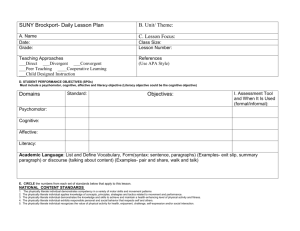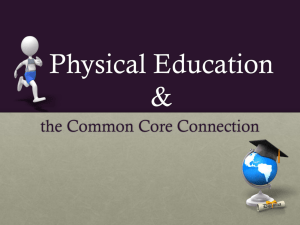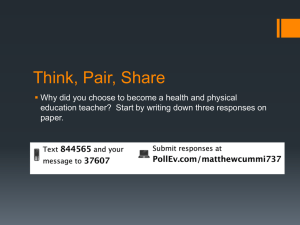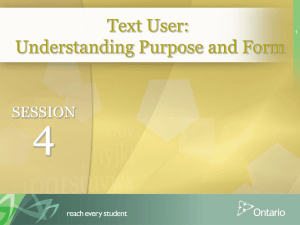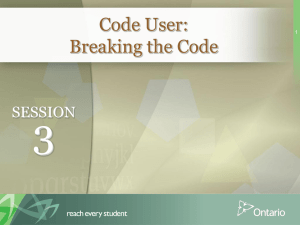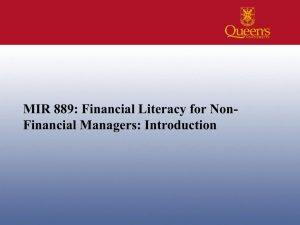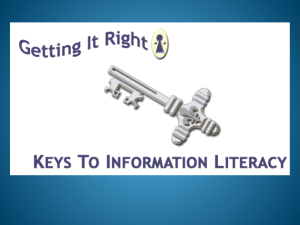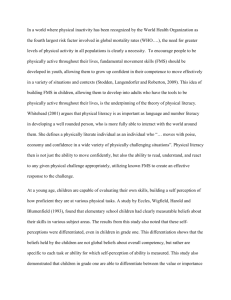SHAPE_2014
advertisement
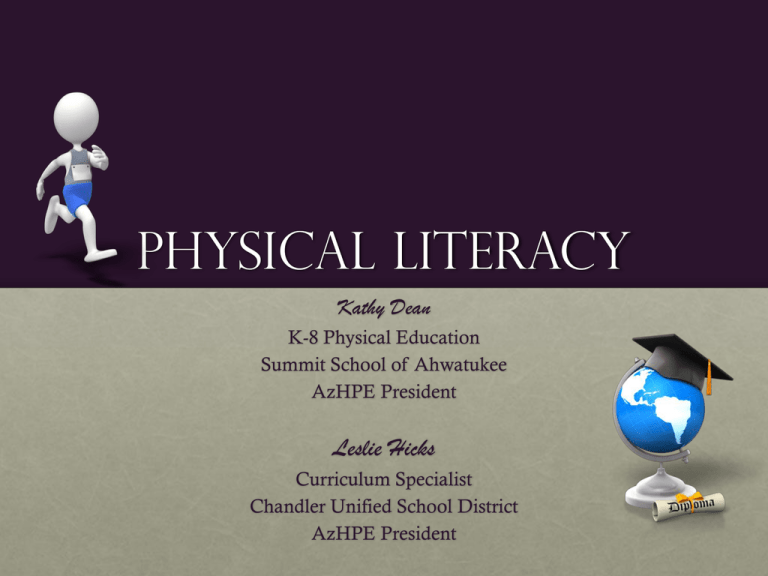
Physical Literacy Kathy Dean K-8 Physical Education Summit School of Ahwatukee AzHPE President Leslie Hicks Curriculum Specialist Chandler Unified School District AzHPE President Physically literate The goal of physical education is to develop physically literate individuals who have the knowledge, skills and confidence to enjoy a lifetime of healthful physical activity. To pursue a lifetime of healthful physical activity, a physically literate individual: • Has learned the skills necessary to participate in a variety of physical activities. • Knows the implications of and the benefits from involvement in various types of physical activities. • Participates regularly in physical activity. • Is physically fit. • Values physical activity and its contributions to a healthful lifestyle. Physical Literacy Physical and Health Education Canada defines physical literacy as: • Individuals who are physically literate move with competence and confidence in a wide variety of physical activities in multiple environments that benefit the healthy development of the whole person. • Physically literate individuals consistently develop the motivation and ability to understand, communicate, apply, and analyze different forms of movement. • They are able to demonstrate a variety of movements confidently, competently, creatively and strategically across a wide range of health-related physical activities. • These skills enable individuals to make healthy, active choices that are both beneficial to and respectful of their whole self, others, and their environment. What does content literacy mean? • Content literacy is usually defined as “the ability to use reading and writing for the acquisition of new content in a given discipline”. (p. 184) [McKenna & Robinson, R.D. (1990), Content reading and literacy: A definition and implications. Journal of Reading, 34, p.184-186]. • In recent years, the ability to use oral language (small-and large-group discussion) in mediating students’ learning has been added to this definition. Meeting CC & Content Standards • Understand the College & Career Readiness Standards • Identify connections between College & Career Readiness Standards and Physical Education/Health Standards Reading – anchor standards Reading Reading Writing Writing Writing Writing Writing Take a close look at the physical education standards K-12 physical education standards Standard 1. The physically literate individual demonstrates competency in a variety of motor skills and movement patterns. Standard 2. The physically literate individual applies knowledge of concepts, principles, strategies and tactics related to movement and performance. Standard 3. The physically literate individual demonstrates the knowledge and skills to achieve and maintain a health-enhancing level of physical activity and fitness. Standard 4. The physically literate individual exhibits responsible personal and social behavior that respects self and others. Standard 5. The physically literate individual recognizes the value of physical activity for health, enjoyment, challenge, self-expression and/or social interaction. A Look at the new national pe standards A. Executes at least one the following offensive tactics to create open space: moves to open space without the ball; uses a variety of passes, pivots and fakes; give & go. (S2.M2.6) B. Identifies physical activity benefits as a way to become healthier. (S3.E1.3b) C. Analyzes the impact of food choices relative to physical activity, youth sports & personal health. (S3.E6.5) D. Explains how body systems interact with one another (e.g., blood transports nutrients from the digestive system, oxygen from the respiratory system) during physical activity.18 (S3.M14.8) E. Evaluates the validity of claims made by commercial products and programs pertaining to fitness and a healthy, active lifestyle.29 (S3.H2.L1) Instructional Strategies • Vocabulary knowledge is strongly related to successful text comprehension, and it is especially important in teaching English language learners (Allen, 1999). • Opportunities for students to use words in meaningful ways • Word Squares Hopkins, G. & Bean, T. (1999). Vocabulary learning with the verbal-visual word association strategy in a Native American community. Journal of Adolescent & Adult Literacy, 42(4), 274-281 Words in Context ©Janet Allen Allen, J. (1999). Words, words, words: Teaching vocabulary in grades 4-12. Portland, ME: Stenhouse. Concept Map List, group, label, and write Students will be asked to categorize or group terms or concepts based on their common elements. This is a brainstorming strategy in which students recall as many terms as possible on a given topic and then group these terms according to their similarities. It can be used before and after reading a selection. Before Reading Ask the class to think of all the words that come to their minds on the topic to be studied. The topic could be anything about which they have some prior knowledge. Then display these terms on the board or an overhead transparency. The teacher may chose to introduce significant terms at this time as well. Either as a class or in small groups, have students group the terms displayed. They need to explain why they choose to put certain words/phrases in a particular category. Wood, Karen D. and D. Bruce Taylor. (2006). Literacy strategies across the subject area (2nd ed.). Boston:Pearson Publishing. Quick writes Word chains Overview: Explore concepts in relation to each other; extend students’ understanding of concepts; support metacognitive awareness as students justify links (connections) they form among the words. Procedure: Step1: Select (5-10) terms or have students select them. Step 2: Decide the physical format of the chain and prepare materials (word cards, template, strips, and software like Inspiration). Step 3: Students work individually, in pairs, or in small groups to develop chains. Step 4: To make connections use discussion, write a brief paragraph, draw vocabulary graffiti* or some other graphic representation. Step 5: Write in the cloud how these words are linked together. Word chain Word poster • Decide what the posters must include. At minimum, consider requiring the following: • The word, written in large letters (perhaps as Vocabulary Graffiti). • A definition of the word. • The context in which the word was found. • An image, such as a funny cartoon or drawing, to support the term’s meaning. • An original sentence using the word. Socratic seminar Socratic seminar Socratic Seminar – Inside/Outside Circles 1. Outline the two sides of the coin. a. Inside circle will address Knowledge and Skills view. b. Outside circle will address Physical Activity view. 2. How might these two different views impact WHAT is taught? Paragraph 4 a. Outside circle: Knowledge/Skills = b. Inside circle: Physical Activity = 3. What might be the dangers of these two separate views? Paragraphs 5 & 6 4. What support is given in the article, that these two views are two sides of the same coin? Paragraph 7 5. How does the author suggest we accomplish this? What ideas can you share? Paragraph 10 Fitness for life Fitness for life Summary writing in sport education Summary Writing: Sport Education Scenario for Text Frame : Character Analysis TEXT FRAME: Character Analysis Mia Hamm – Winners Never Quit! ___________is an important character in our story. ____________is important because _______________. Once he/she____________. Another time, ___________________. I think that______________is_______________ Because_____________________. Resources • Physical Best • Fitness for Life • Sport Education • Great Body Shop • Choices by Scholastics • Active Learning Specialist by FIZIKA • KidsHealth, TeenHealth • Quizlet.com
